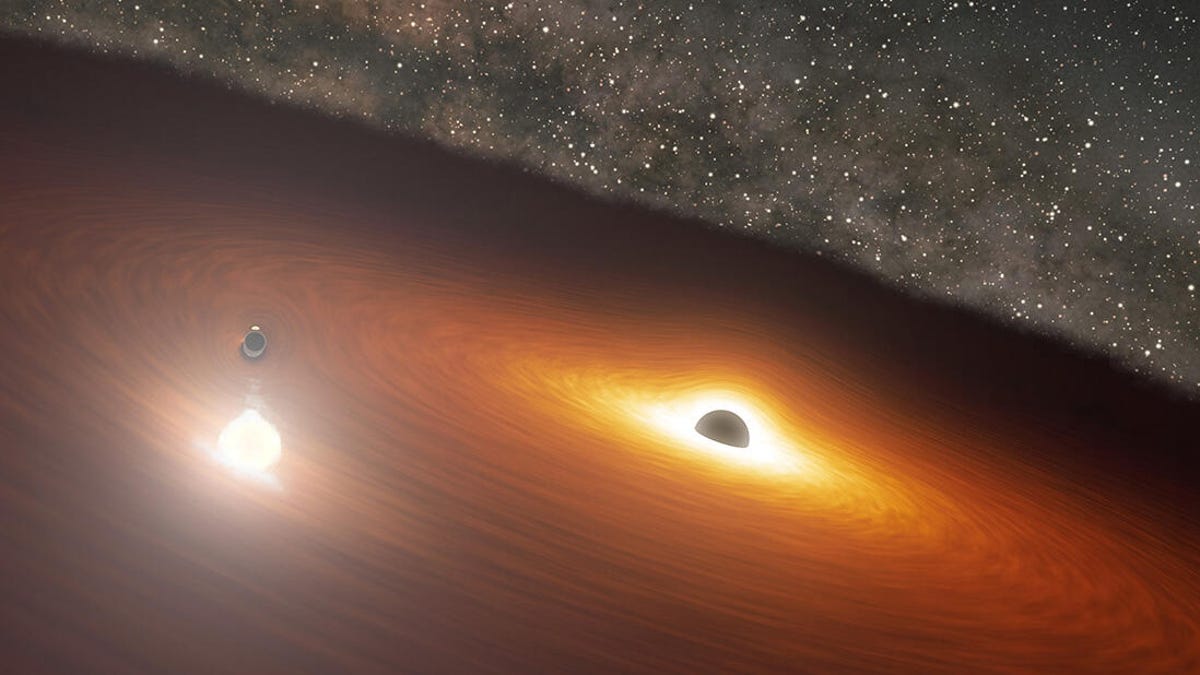Dancing black holes create mega flare brighter than one trillion stars
OJ 287 is a black hole binary system that puts on an extreme light show every 12 years.

When a small black hole (left) crashes through the accretion disk of the OJ 287 galaxy it creates a flare brighter than 1 trillion stars.
In the OJ 287 galaxy, about 3.5 billion light-years from Earth, two black holes are trapped in an endless dance. The supermassive black hole at the center of the galaxy is about 18 billion times more massive than the sun -- one of the largest black holes we have ever found. It's dancing partner, much smaller but still huge, is only 150 million times more massive than the sun.
Every 12 years, the smaller dancer crashes through a huge disk of debris swirling around the supermassive black hole. When it does so, it creates an explosion of light we can visualize from back on Earth because its brighter than one trillion stars. A mega flare. This epic animation below, from NASA's Jet Propulsion Laboratory, captures the phenomenon perfectly.
But the dance is kind of awkward.
The smaller black hole doesn't have perfect timing. It crashes through the disk at irregular intervals because of its oblong orbit, making it hard for scientists to watch for exactly when the next explosion of light might occur. So in 2010, a team of researchers set out to create a model to predict when they might next see the next mega flare. Their model correctly predicted the appearance of a flare to within three weeks.
Then in 2018, scientists from the Tata Institute of Fundamental Research in Mumbai, India, were able to refine the model to predict the next flare would peak on July 31, 2019. They wrote that if they could observe the flare it might give them a good chance to test the "no-hair theorem", which posits black holes are smooth and symmetrical.
A new study, published in the Astrophysical Journal Letters on Tuesday, demonstrates the scientists' predictions for when the flare would occur were right on the money -- and fortunately NASA's Spitzer telescope was looking at OJ 287 at just the right time.
"When I first checked the visibility of OJ 287, I was shocked to find that it became visible to Spitzer right on the day when the next flare was predicted to occur," said Seppo Laine, an associate staff scientist on Spitzer based at Caltech, in a release. Notably, Spitzer, which was retired in January this year, was the only telescope with a clear view of the galaxy at the time of the flare.
"It was extremely fortunate that we would be able to capture the peak of this flare with Spitzer, because no other human-made instruments were capable of achieving this feat at that specific point in time," said Laine.
And Spitzer's lucky glance provided more evidence for the no-hair theorem. The scientists predictions about when the flare would peak gave them more accurate information about the cosmic dancers and the orbit of the smaller black hole. Because the smaller black hole crashed through the debris disk just when scientists predicted, it suggests OJ 287's supermassive black hole is symmetrical and smooth. A win for the no-hair theorem.
This dance will ultimately end in catastrophe. The smaller black hole's orbit is decaying over time, bringing it ever closer to its dancing partner. The supermassive black hole will swallow up its smaller dancing partner sometime within the next 10,000 years.

